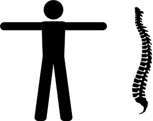 myCSUSM
myCSUSMBack Safety
Hinge at hips and bend knees when lifting. Pick up items with legs rather than the back! Placing feet shoulder-width apart helps to stay balanced. A wider stance can also help when experiencing difficulty bending the knees.

Tighten stomach muscles before lifting. They help support/stabilize the back.
Plan ahead before lifting. Test the weight first. Many injuries result from poor planning and overexertion.
Keep objects close. A 10 pound bag of groceries can put 100 pounds of pressure on the lower back. Holding items away from the body greatly increases this pressure.
When possible, use hands and arms for added support when bending and lifting. Use a golfer's lift to retrieve light objects, or when reaching into low containers like a hamper or shopping cart.
Pivot feet when lifting and moving objects. Turn the whole body instead of twisting the spine, especially if holding something heavy. The nose should always be in-line with the toes.
Balance objects when being carried. Use dollies and carts for heavy items whenever possible. Use body weight to push a dolly or cart with the legs, rather than pulling with arms or back.
Use a bookstand or document holder to elevate reading materials. Looking down puts a tremendous train on the neck and upper back.
Get as comfortable as possible in the car. Long commutes can be hard on the back. Adjust seat and position arms so that they can easily reach the steering wheel. Use a pillow in the seat if needed to support the lower back curve. Stop to take stretch breaks when driving for extended periods.
Sleep on a firm mattress providing good support. Place a pillow under the knees when resting on back, or between knees if laying on the side of body.
Stay in good shape. Exercise. Do daily stretches and watch body weight. Additional weight, muscle weakness, or muscle imbalances (due to tightness) can affect posture and result in back discomfort or pain.






